Key takeaways:
- Photography in campaigns serves as a powerful storytelling tool, evoking emotion and engagement beyond what words can achieve.
- Different styles of photography—portrait, product, and lifestyle—each play a unique role in shaping audience perception and enhancing connection.
- Crafting a photography strategy involves understanding the core message, knowing the audience, and being flexible to capture authentic moments.
- Editing techniques and the impact of visuals can significantly influence how a campaign’s message is received and engaged with by the audience.

Understanding Photography’s Role
Photography in campaigns isn’t just about pretty pictures; it’s about storytelling. I remember a campaign I worked on where we used a single, powerful image of a smiling child holding a water filter. That photograph spoke volumes, evoking empathy in ways words alone couldn’t. Have you ever felt that instant connection with an image? It’s that magic that can make or break a campaign.
When I tailor a photo for a specific audience, I consider the emotions I want to evoke. For example, during a fundraiser for environmental conservation, I chose images that depicted both the beauty of nature and its devastation. It’s striking how a before-and-after shot can trigger a sense of urgency—almost like a call to action. Can a photograph ignite your passion for a cause as much as a well-crafted speech?
In my experience, photography often dictates the mood of the entire campaign. I’ve found that high-contrast images create a sense of drama and urgency, while softer, pastel colors can invoke calm and trust. Isn’t it fascinating how a small tweak in visual presentation can shift perceptions and encourage support? That’s the power of photography—each shot is a carefully crafted invitation to engage with the message behind it.
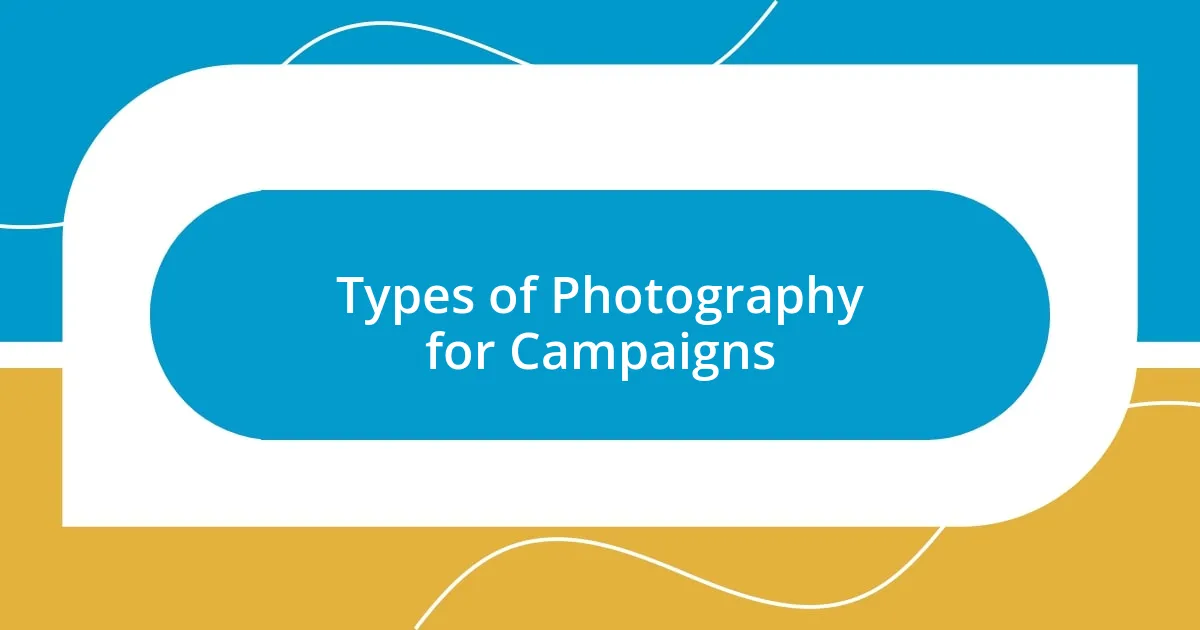
Types of Photography for Campaigns
When I think about the types of photography that work best in campaigns, I often consider portrait photography to be one of the most impactful. Capturing genuine expressions can create a personal connection, often leaving a lingering impression on the audience. I recall a project where we featured real beneficiaries of our program. The authenticity in their smiles made potential contributors see the faces behind the statistics, which boosted engagement. Have you ever paused to really look into someone’s eyes in a photo? It’s a powerful experience.
On the other hand, product photography serves a different purpose yet is equally crucial. It’s about showcasing the benefits and features of what you’re promoting. I once worked on a health campaign where we had to make the product stand out. By using sharp, clean images highlighting the product’s vitality, we saw an increase in interest. It’s simple—how a product is visually presented can heavily influence perceptions. Have you noticed how a well-lit, attractive photo can make you want to try something on the spot?
Lastly, lifestyle photography allows me to narrate a broader story within a campaign. It situates the product or cause within everyday life, making it relatable. I remember taking photos for a campaign promoting outdoor fitness. We showed people enjoying nature while exercising. The joy captured in those moments made the idea of being active more appealing. Isn’t it interesting how a simple activity can inspire many to join in?
| Type of Photography | Purpose |
|---|---|
| Portrait Photography | Creates personal connections by showcasing genuine expressions |
| Product Photography | Highlights product features to influence perceptions and encourage action |
| Lifestyle Photography | Narrates broader stories, making the cause or product relatable and appealing |
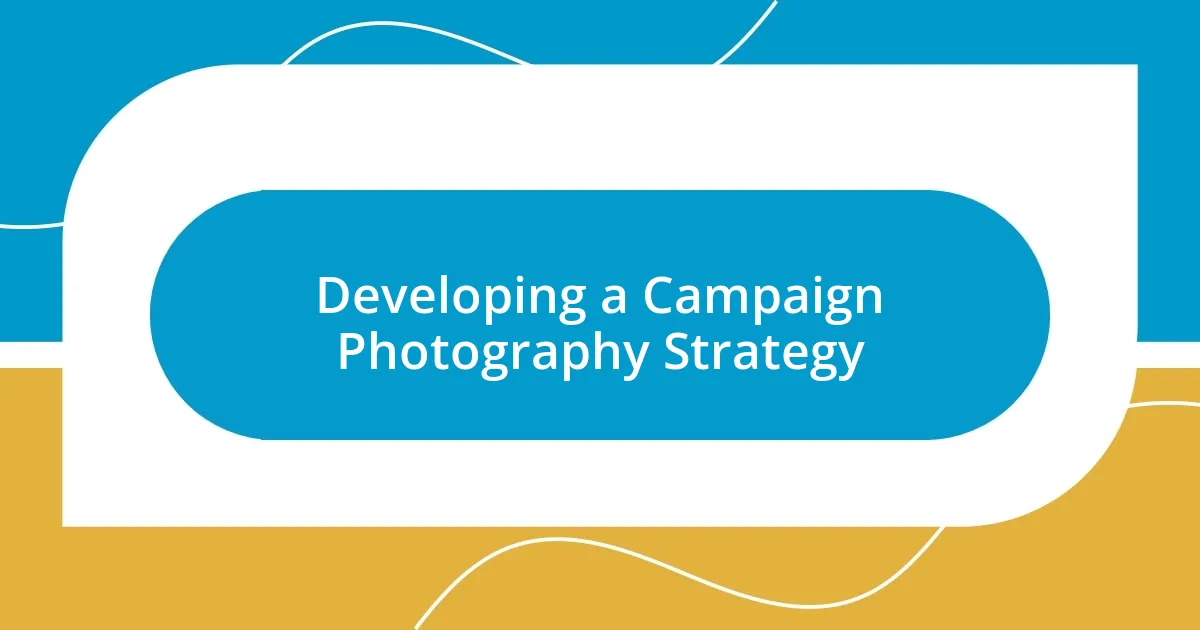
Developing a Campaign Photography Strategy
Developing a campaign photography strategy requires careful planning and a clear vision of what you want to achieve. I like to start by identifying the campaign’s core message and who the target audience is. This focus helps shape the visual narrative. For instance, I once led a local initiative aiming to support small businesses, and by spending time in the community, I captured images that resonated deeply with the audience. Those photos weren’t merely visuals; they became relatable stories of resilience and passion that the community embraced. It’s incredible how focused imagery can foster a sense of belonging and ownership among viewers.
Here are key steps I recommend for crafting your photography strategy:
- Define your core message to shape the imagery.
- Know your target audience and their emotional triggers.
- Plan specific types of shots to avoid ambiguity.
- Scout locations that align with your message and aesthetics.
- Coordinate with your team to ensure everyone understands the visual goals.
- Review and analyze past campaigns to identify what resonated.
- Remain flexible during shoots to capture unexpected, powerful moments.
It’s this blend of strategy and spontaneity that fuels impactful campaigns for me. And honestly, embracing this balance has made a world of difference in how I approach photography in my work. Each campaign offers a chance to dig deeper and reveal stories that are waiting to be told.
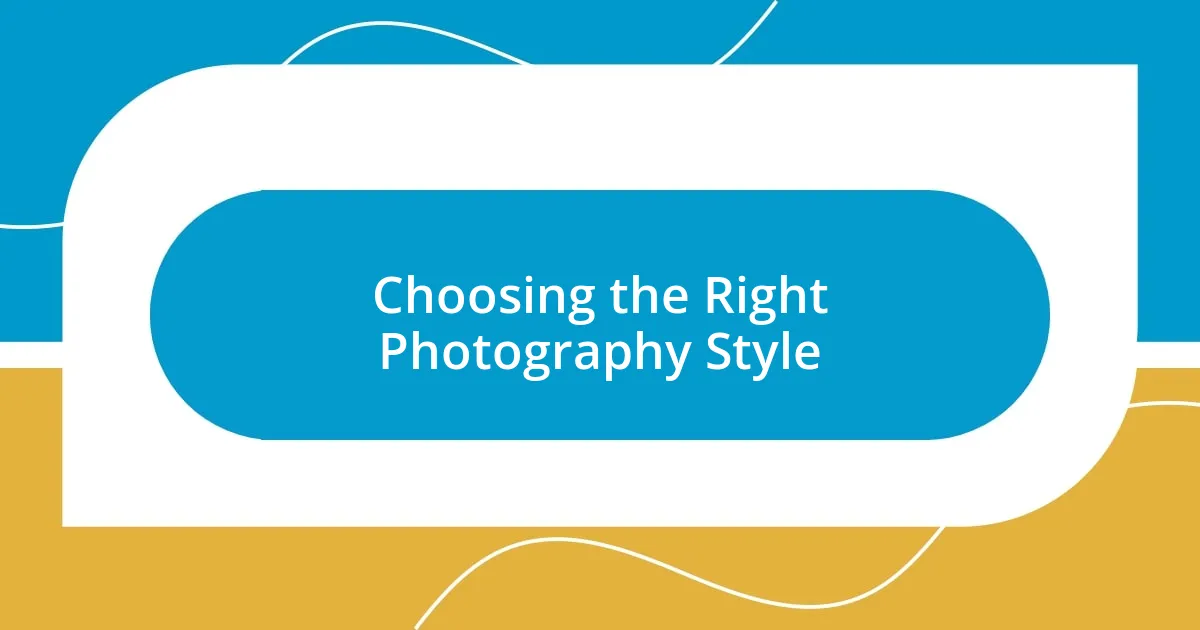
Choosing the Right Photography Style
When choosing the right photography style for a campaign, I often find myself reflecting on the emotions I want to provoke in my audience. For example, during a community outreach project, we opted for a documentary style that captured raw, unfiltered moments. Those images conveyed a deeper emotional resonance, pulling viewers into the narrative and prompting them to care about the cause. Have you ever felt moved by an effortlessly taken snapshot? It’s these unscripted moments that linger in our minds and hearts.
I also pay close attention to the campaign’s overall tone. For a polished corporate initiative, sleek, modern product photography can really elevate the message, while a playful style might suit a community-focused initiative better. In one campaign aimed at encouraging youth participation, I used vibrant colors and dynamic angles to showcase the excitement of the events. The visual energy we captured stirred enthusiasm and made the project feel accessible. How do you think the style of a photo influences your perception of a brand or cause?
It’s essential for me to consider the visual storytelling aspect as well. With a recent environmental campaign, I chose a nature-inspired aesthetic, emphasizing the serenity of the landscapes we aimed to protect. By harmonizing the photography style with the message, we created a narrative that didn’t just promote awareness but inspired action. Isn’t it fascinating how the right style can transform a simple image into a call to arms?
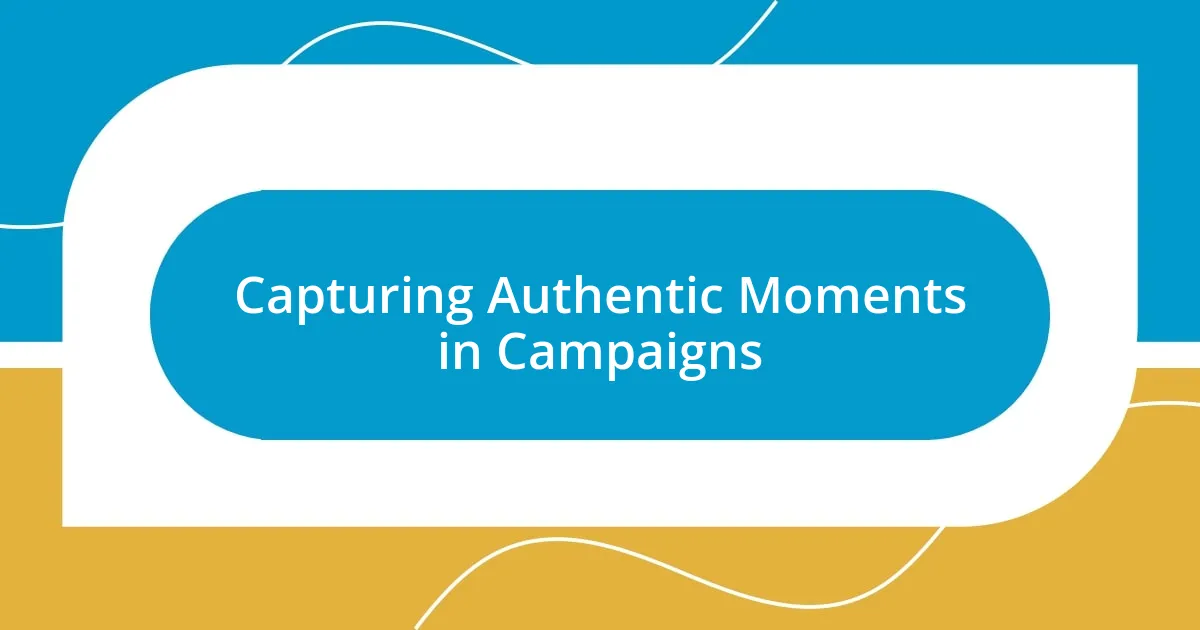
Capturing Authentic Moments in Campaigns
Capturing authentic moments in campaigns is something I genuinely strive for. During a recent charity event, I found myself amidst an unplanned, heartwarming exchange between a volunteer and a participant. I snapped the moment, and that one photo encapsulated the entire spirit of the event—the smiles, the laughter, the humanity. It’s moments like these that remind us why we’re doing what we do. Isn’t it amazing how a single image can carry the weight of an entire experience?
I also believe in the power of storytelling through candid imagery. At a local festival, I decided to focus on capturing behind-the-scenes moments rather than just staged shots. The joy on people’s faces while they prepared food or set up decorations created a vibrant narrative full of energy. These authentic visuals not only conveyed the event’s essence but helped viewers feel like they were a part of it, even if they weren’t there. Have you ever caught yourself smiling at a picture that effortlessly conveys joy? That’s the magic of authenticity in photography.
Flexibility during shoots is crucial for capturing genuine moments. During a community clean-up project, I kept my camera close and was ready to pivot at a moment’s notice. When I noticed a child helping an older resident pick up trash, I instinctively captured that act of kindness. The resulting image brought a tear to my eye—it wasn’t just about the cleanup; it was about connection and community. Isn’t it incredible how spontaneity often leads to the most compelling visuals?
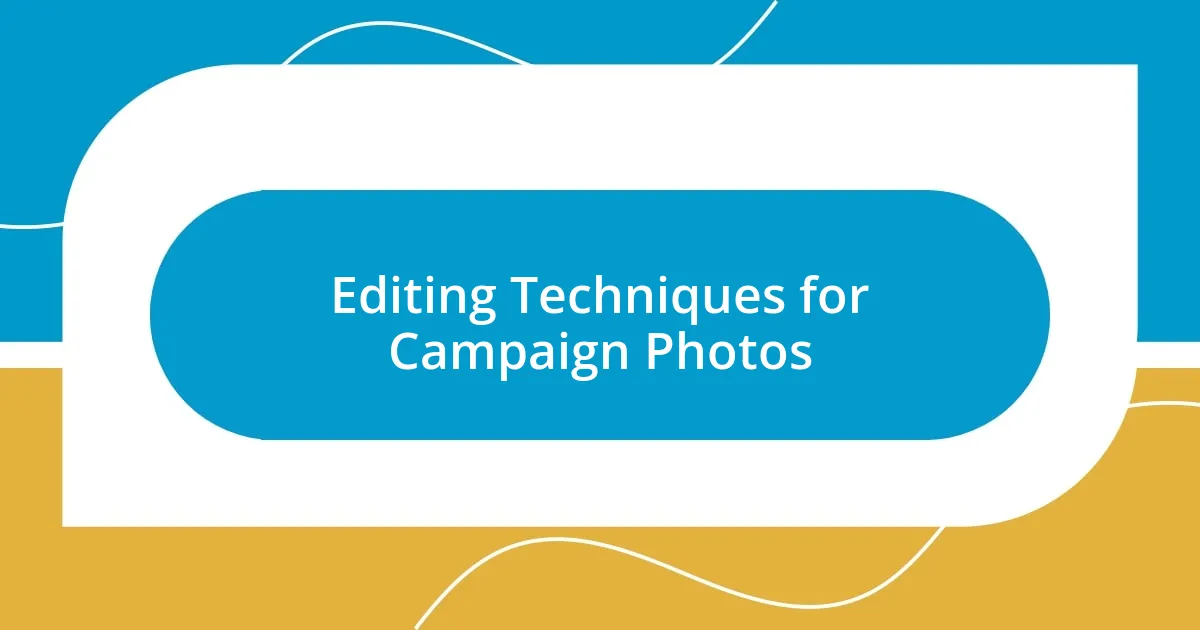
Editing Techniques for Campaign Photos
Editing Techniques for Campaign Photos
I’ve often found that editing is where the magic truly happens. After a recent awareness campaign, I faced hundreds of images, all brimming with potential. I selected a few and enhanced their brightness to reflect the overall optimism of the event. Making those small adjustments can transform an already great photo into an impactful tool that resonates with viewers. How often do you find that a little tweak can change the entire feel of an image?
One technique that has consistently worked for me is applying a cohesive color palette. During a fundraising campaign, I used warm tones to evoke feelings of comfort and kindness. By adjusting the saturation and contrast, each image not only complemented the others but created a rich visual narrative throughout the campaign. This consistency helped to enhance the brand’s identity and made the project feel unified. Can you see how color influences your emotional response to a series of images?
I also appreciate the power of cropping. Sometimes, all it takes is framing the photograph differently to draw focus to what truly matters. In a recent event showcasing local artists, I found myself cutting out distractions and centering the artwork along with the artist’s expression. The simplicity of the edit highlighted the passion and creativity behind the work, adding layers to the story being told. Isn’t it fascinating how such a simple adjustment can unlock a whole new dimension in a photograph?
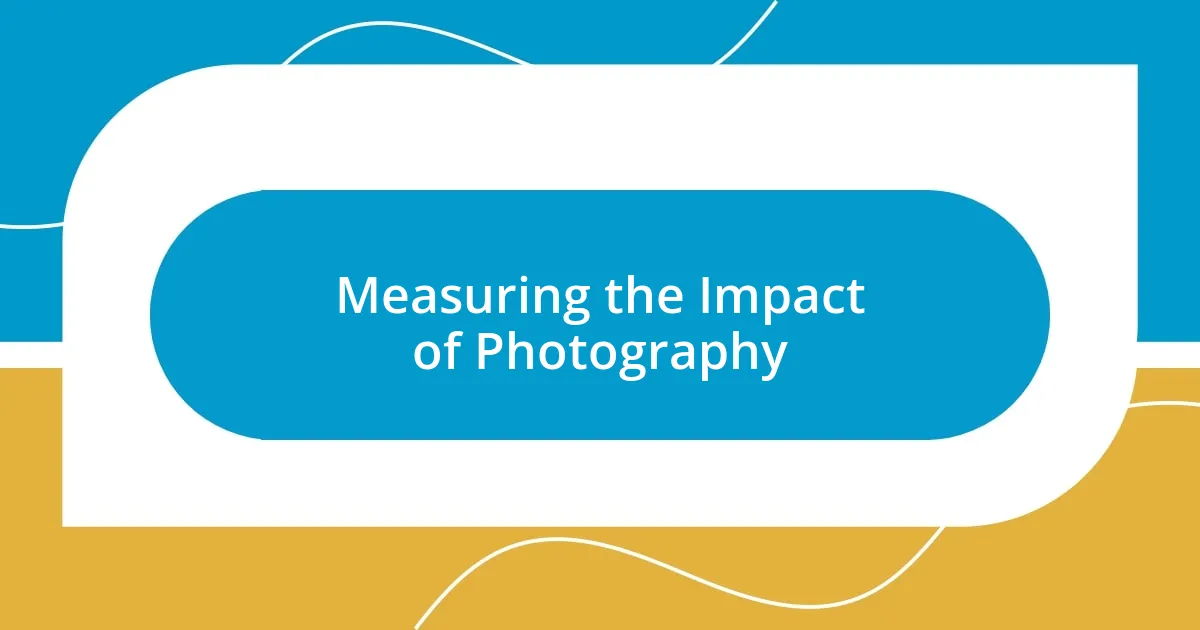
Measuring the Impact of Photography
Measuring the impact of photography in campaigns can be quite insightful. I remember a time when I adjusted my approach based on the response to a series of photos I shared online. After analyzing engagement metrics, such as likes and shares, I noticed that images showcasing emotional connections—like a parent’s pride at an award ceremony—resonated far more than generic group shots. Isn’t it fascinating how quantifiable data can guide our creative choices?
To dig deeper, I often solicit feedback directly from my audience. After posting images from a community outreach campaign, I posted a simple poll asking which photos they felt connected with the most. The results surprised me! The images depicting candid interactions held far more weight against staged promotional shots. I find that direct engagement enriches my understanding of what truly matters to my audience. Have you ever considered how engaging your fans can help perfect your craft?
Finally, I always revisit the storytelling aspect when reviewing the impact of my images. During a recent campaign focused on mental health awareness, I observed how certain images sparked conversations in the comments section, prompting heartfelt discussions. This kind of organic dialogue is invaluable. It reinforces the notion that photography is not just about what we see; it’s about what we feel and how it can inspire change. Isn’t the ability to motivate dialogue through a single image genuinely empowering?












